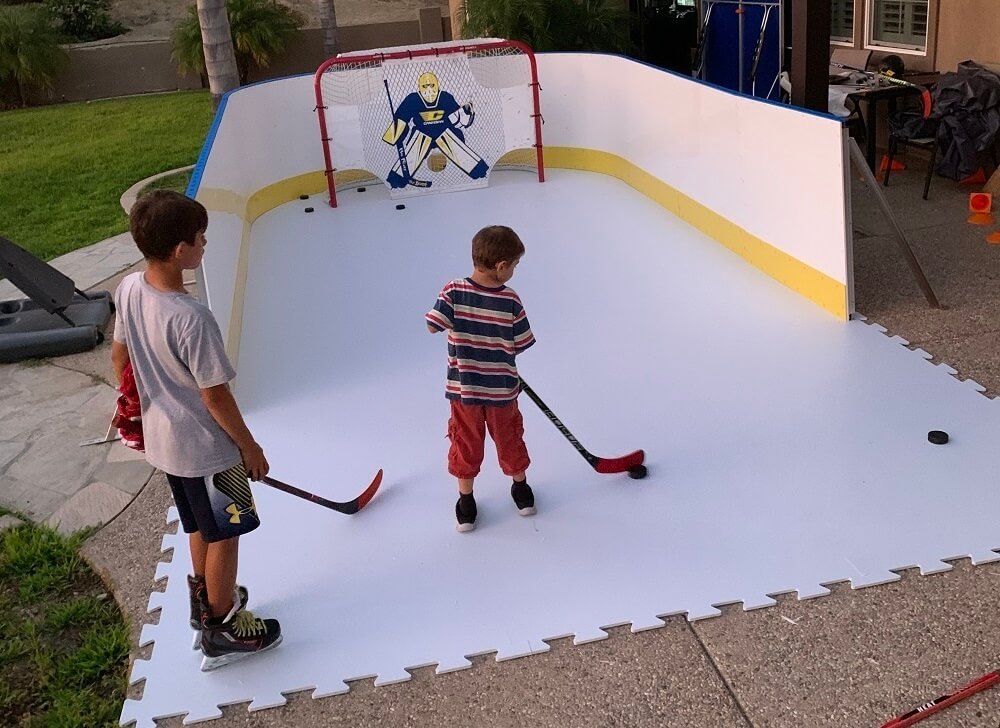Synthetic Ice Vs. Real Ice

There has been a lot of talk about synthetic ice over the last several months among hockey players and ice skaters that were stuck at home during the pandemic. The great thing about synthetic ice panels is that they are versatile enough to install in the home, out in the backyard, or even in the garage and allow skaters to ice skate any time they want to. But, is artificial ice better than the real deal? You might be surprised.
Real Ice and Skates
There are a couple of problems that accompany being able to ice skate on real ice:
- It has to be kept frozen
- It is not easy to maintain
As most folks are already aware, ice is formed when water freezes. The moment the temperature becomes higher than the freezing temperature ice begins to melt and turn right back into its original form of water. This makes ice rinks very difficult to maintain because they are so large.
However, real ice is nice to skate on. When ice skaters skate across the frozen surface of the rink, their skate blades cause a little bit of heat to form on the ice. This heat, in turn, causes a little bit of the water to melt on top of the ice as the skates glide across. This water makes it easy for the skates to slide across it without much resistance. What makes ice such a great surface to skate on is the very fact that it does melt, a little.
Synthetic Ice and Skates
In the very early stages of artificial ice back in the 1960s there were quite a few drawbacks. Plastic back in those days was not as advanced as it is today so it was challenging to keep the flooring slick enough for the ice skates to successfully skate on it.
Back then, the only way for skaters to be able to glide somewhat as they did on real ice, was if there was a constant supply of lubricant added to the flooring. As the skaters would skate, a lubricant would be added every half of an hour or so in order for the floor to be slick enough for skating.
Nowadays, it is much different. Plastics have come a long way and so has synthetic ice. Developers have been able to use polymer chain technology to create dynamic plastic that can be changed and formed at the molecular level. Now instead of lubricants that have to be constantly added to the floor by an outside source, the lubricants are built right into the flooring and are released when ice skate blades glide across the surface, much like the way real ice works.
Synthetic Ice Might Be Better
One of the drawbacks of ice skating on synthetic ice is that there is a slight drag and a bit of resistance when the skater moves about across the flooring. It is not enough of a drag to make skating difficult, but it is a difference. The upside of this resistance is that builds strength and endurance for the skaters.
The drawback of using real ice for ice skating and hockey is that the entire building that the ice is housed in has to be cooled to a temperature low enough to keep the water frozen. If it is upwards of 80 degrees Fahrenheit outside, it takes a lot of energy to run the equipment that it needs to keep things frozen. This alone can cost thousands of dollars each month to sustain and can cause a substantial amount of pollution to occur.
All in all at the end of the day, when you compare synthetic ice to real ice it all depends on the way you see things that will make one better than the other one. Synthetic ice is manufactured in factories that could cause environmental problems, while real ice needs a super high amount of energy to stay frozen. One you can easily install in your home while the other would be kind of difficult to sustain. Either way, you can choose what is best for you and whatever makes you feel better.
***Sniper’s Edge Hockey loves Canada! We proudly ship all of our products to Canada and offer the same return policies as we do for everybody else. We realize the exchange rates for the Canadian dollar are not the best right now, so we’re trying to help by giving you free shipping and no customs/duty.***

/Field-hockey-5680a7da3df78ccc15a74184.jpg)

